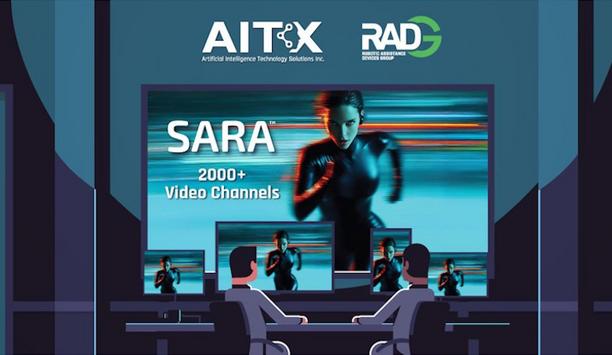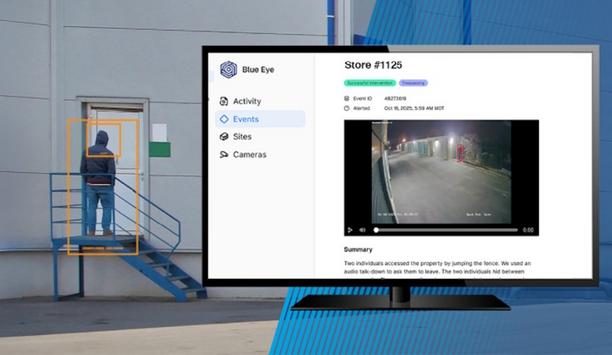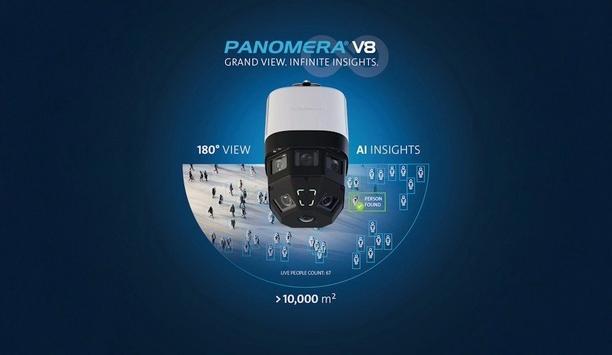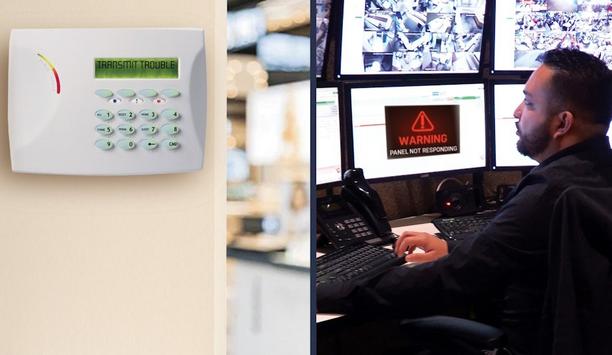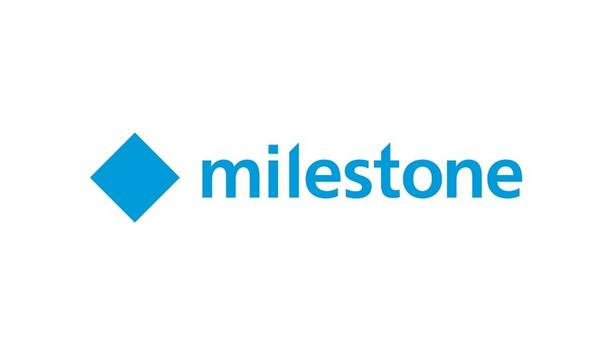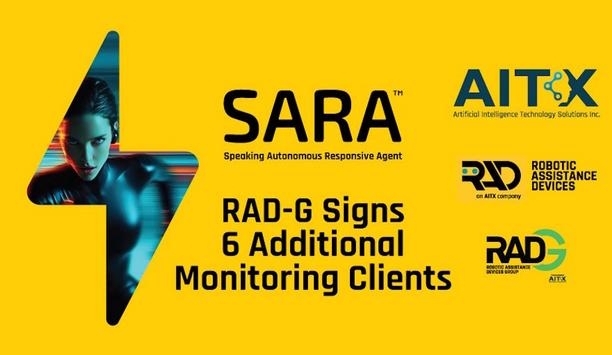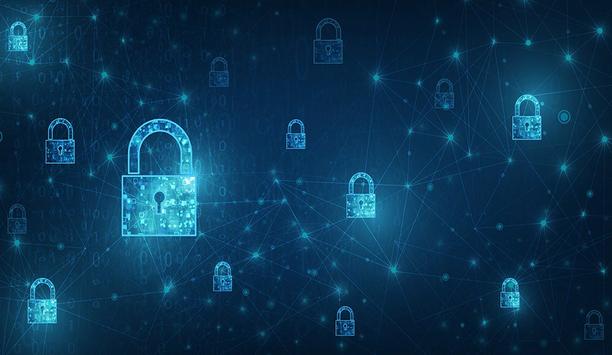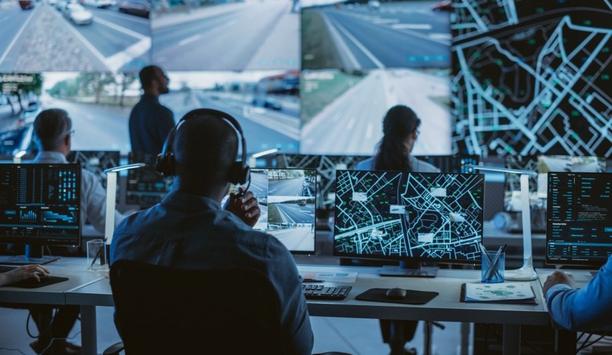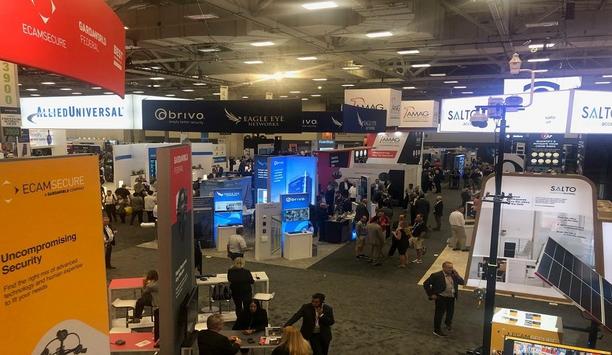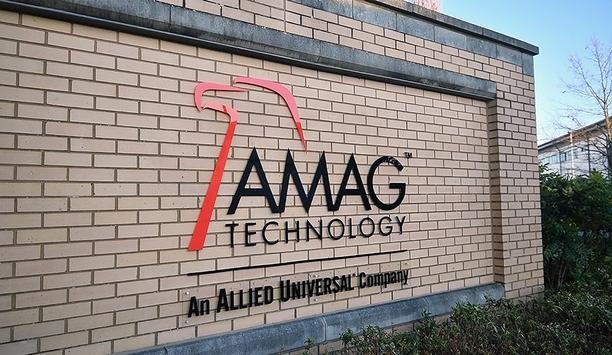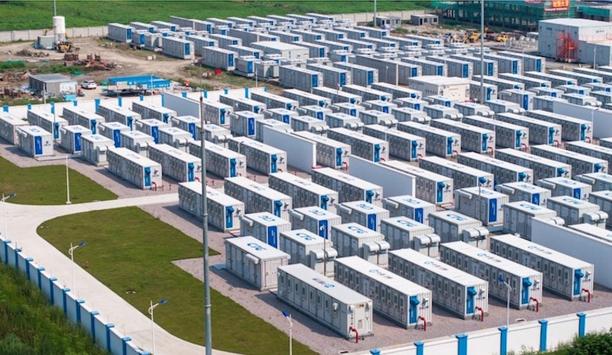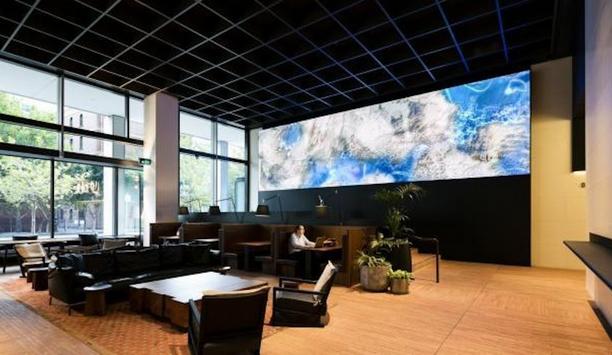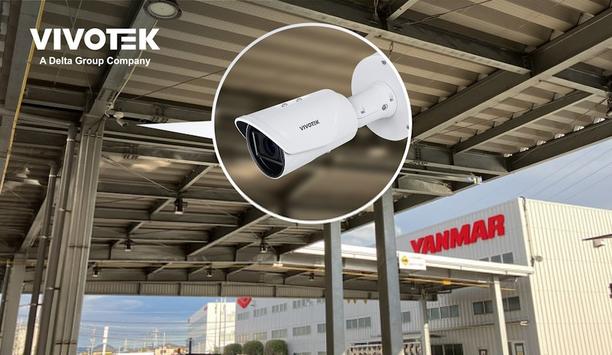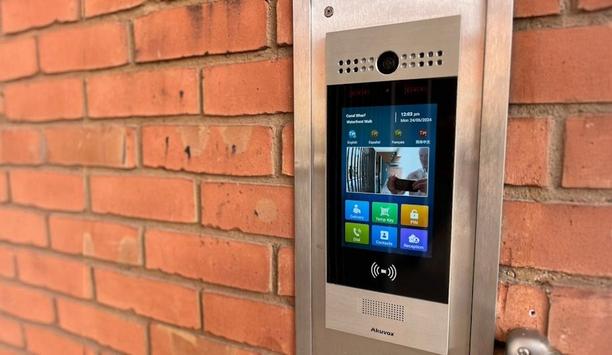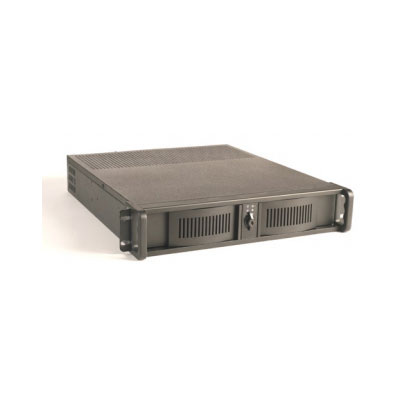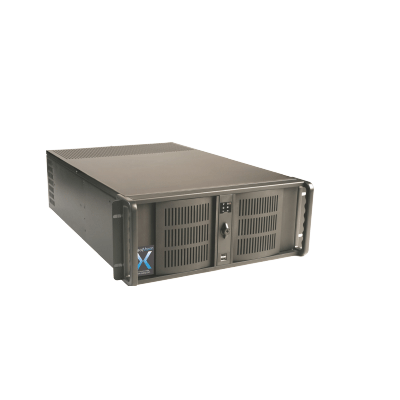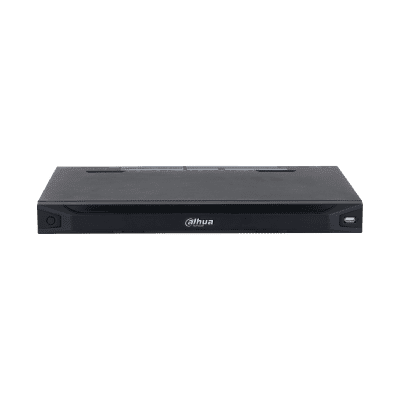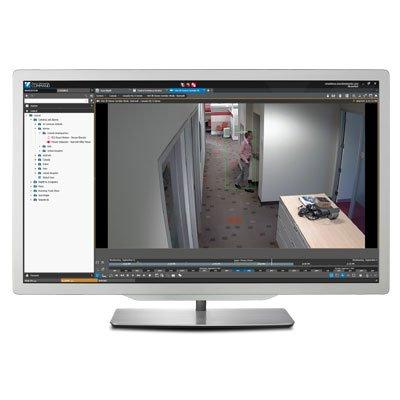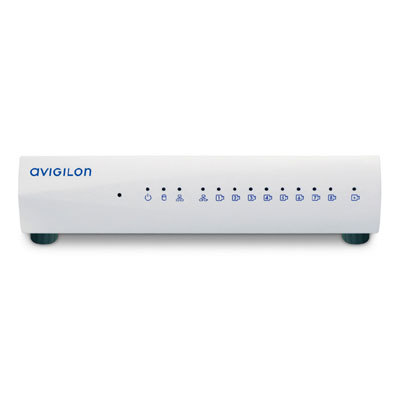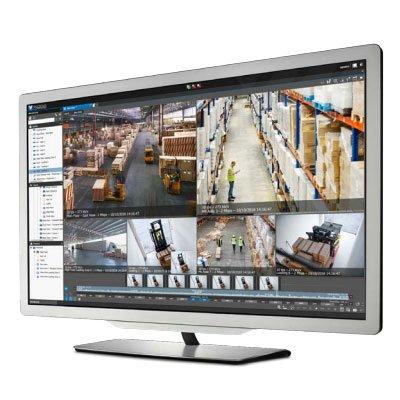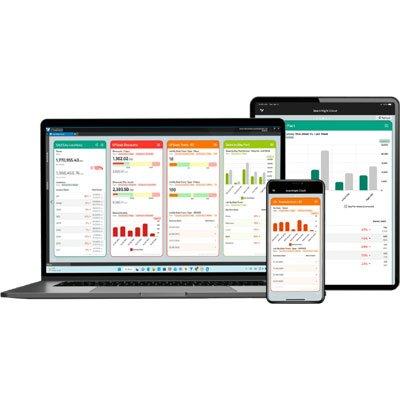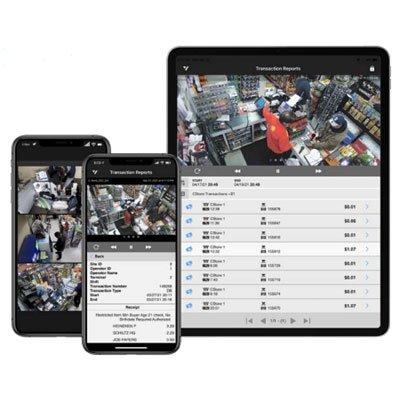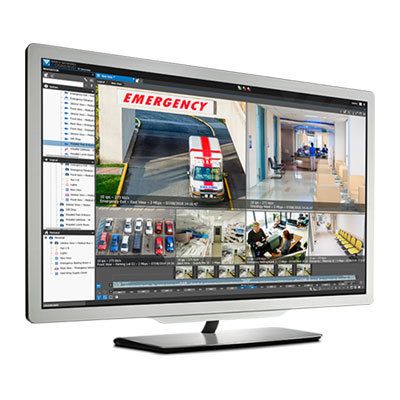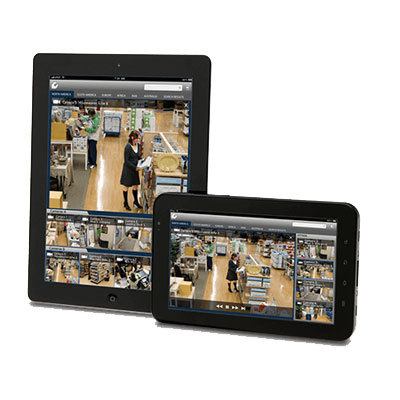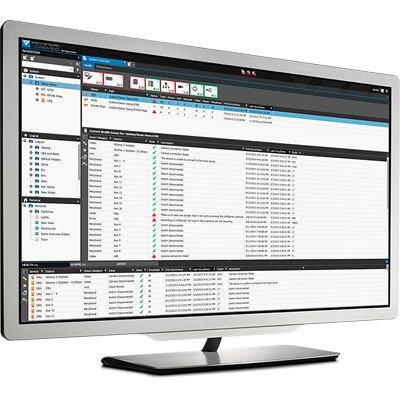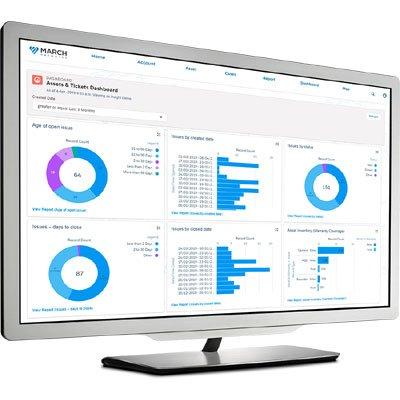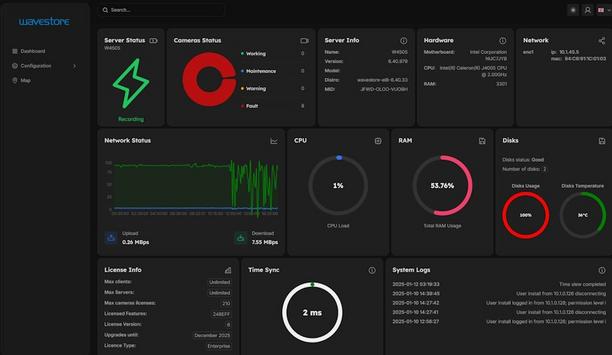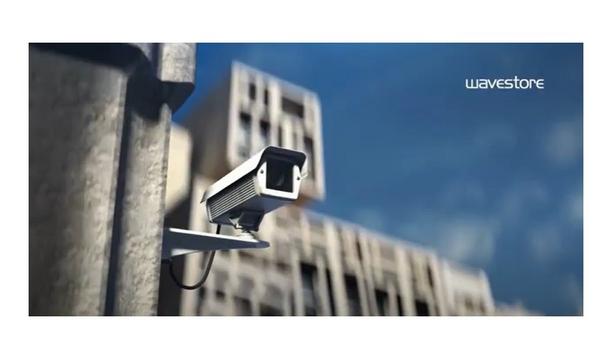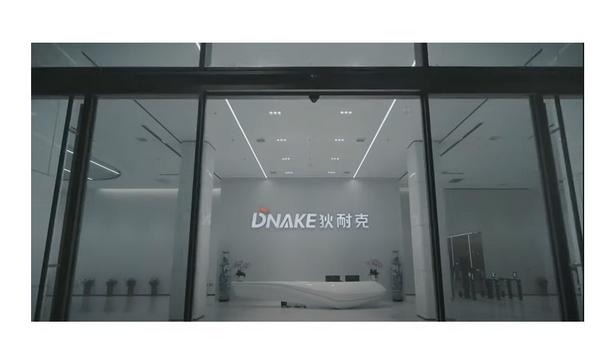Remote video monitoring
Deep Sentinel, the pioneer in AI-powered proactive video surveillance with real-time human intervention, now announced the launch of its Mobile Monitoring Trailer — a fully mobile, solar-powered security platform that delivers instant access to Deep Sentinel’s remote live guard monitoring anywhere, including places where power and permanent infrastructure are unavailable. Purpose-built for high-value outdoor environments, such as auto and parking lots, construction sites, industrial...
Alarm.com and Everon, LLC, a pioneering security integrator and premier provider of commercial security, video, fire, and life safety solutions, today announced a strategic partnership to deliver a unified console for Everon customers to manage integrated intrusion protection, access control, remote video monitoring, and business management solutions. The partnership reflects the growing demand for integrated commercial security platforms that can easily connect with existing infrastructure whi...
Artificial Intelligence Technology Solutions, Inc., a pioneer in AI-driven security and productivity solutions, along with its wholly owned subsidiary, Robotic Assistance Devices Group (RAD-G), announced a SARA™ contract covering more than 2000 video channels, marking a large agentic AI monitoring deployment. The agreement begins with SARA Verified replacing a competing solution and is expected to progress into SARA Lite and ultimately SARA Agent as the client expands its use of auto...
i-PRO Co., Ltd. (formerly Panasonic Security), a global pioneer in professional security, public safety, and medical imaging solutions, announced it has been officially Certified as a 2025 Great Place to Work across all regions where it operates, including Japan, the Americas, EMEA, Asia Pacific and China. The certification reflects i-PRO’s ongoing investment in a safe, inclusive, and empowering workplace culture. Based entirely on employee feedback, the recognition highlights consistent...
Motorola Solutions announced it has acquired Blue Eye, a pioneering provider of AI-powered enterprise remote video monitoring (RVM) services, based in Salt Lake City, Utah. Blue Eye provides a comprehensive RVM service powered by AI to help detect threats in real time, enabling live voice talk-downs to deter crime and providing verified alerts to help accelerate law enforcement response. Enhanced situational awareness The company’s software platform is interoperable with pioneerin...
Artificial Intelligence Technology Solutions, Inc., a pioneer in AI-driven security and productivity solutions, along with its wholly owned subsidiary, Robotic Assistance Devices Group (RAD-G), today announced the release of SARA™ ASSIST, a new extension to its multiple award-winning SARA (Speaking Autonomous Responsive Agent), the Company's agentic AI platform. Designed for Remote Video Monitoring, GSOC, and SOC environments, SARA ASSIST places agentic AI directly on...
News
Artificial Intelligence Technology Solutions, Inc., a pioneer in AI-driven security and productivity solutions, along with its wholly owned subsidiary, Robotic Assistance Devices Group (RAD-G), has executed a three-year agreement with a U.S.-based RVM (Remote Video Monitoring) company. The project, which is expected to reach $2.5 million in total contract value, will deploy SARA™ (Speaking Autonomous Responsive Agent), the Company’s multiple award-winning agentic AI platform, across the RVM’s growing portfolio of monitored accounts. Range of SARA solutions Under the terms of the agreement, RAD-G will begin the process of deploying a range of SARA solutions with an initial annual value of approximately $855,000. The rollout will occur in phases over the next several months, with full implementation expected to take up to six months as both companies determine the optimal mix of SARA configurations and integrations. Once fully implemented, annual recurring revenue is expected to approach $1 million as the RVM expands its customer base and adds monitored accounts. The project is anticipated to replace three legacy system providers and transition more than 1,000 video monitoring accounts currently managed overseas. How rapidly SARA is redefining “This agreement demonstrates how rapidly SARA is redefining what’s possible in video monitoring,” said Steve Reinharz, CEO/CTO and founder of AITX and RAD-G. “This RVM’s decision to build around our platform validates the strength of our technology, our roadmap, and our vision for autonomous, intelligent monitoring at scale. We’re not following industry trends, we’re setting them.” How SARA can transform its monitoring operations The project adds to RAD-G’s growing portfolio of enterprise software engagements and contributes to the Company’s expanding base of recurring monthly revenue. SARA is designed to autonomously monitor live video streams, identify relevant events, and respond in real time through voice-interactive deterrence and notifications. The platform continues to gain traction as monitoring companies and security providers seek reliable, intelligent, and scalable alternatives to traditional human and offshore monitoring. With each new deployment, RAD-G further advances its mission to modernize security operations through AI-driven automation and actionable intelligence. The Company invites Remote Video Monitoring, GSOC, and SOC operators interested in learning how SARA can transform their monitoring operations to connect with RAD-G at the website. Mobile robotic solutions AITX, through its primary subsidiary, Robotic Assistance Devices, Inc. (RAD), is redefining the nearly $50 billion (US) security and guarding services industry through its broad lineup of innovative, AI-driven Solutions-as-a-Service business model. RAD solutions are specifically designed to provide cost savings to businesses of between 35%-80% when compared to the industry’s existing and costly manned security guarding and monitoring model. RAD delivers these cost savings via a suite of stationary and mobile robotic solutions that complement, and at times, directly replace the need for human personnel in environments better suited for machines. All RAD technologies, AI-based analytics and software platforms are developed in-house. Data protection and security compliance The Company’s operations and internal controls have been validated through the successful completion of its SOC 2 Type 2 audit, which is a formal, independent audit that evaluates a service organization’s internal controls for handling customer data and determines if the controls are not only designed properly but also operating effectively to protect customer data. This audit reinforces the Company’s credibility with enterprise and government clients who require strict data protection and security compliance. Reinforce RAD’s ability to deliver RAD is led by Steve Reinharz, CEO/CTO and founder of AITX and RAD, who brings decades of experience in the security services industry. Reinharz serves as chair of the Security Industry Association’s (SIA) Autonomous Solutions Working Group and as a member of the SIA Board of Directors. The RAD team also draws on extensive expertise across the sector, including Mark Folmer, CPP, PSP, President of RAD and Chair of the ASIS International North American Regional Board of Directors, Troy McCanna, former FBI Special Agent and RAD’s Chief Security Officer, and Stacy Stephens, co-founder of security robotics company Knightscope. Their combined backgrounds in security industry leadership, law enforcement, and robotics innovation reinforce RAD’s ability to deliver proven, practical, and disruptive solutions to its clients. Delivery of artificial intelligence-based solutions RAD has a prospective sales pipeline of over 35 Fortune 500 companies and numerous other client opportunities. RAD expects to continue to attract new business as it converts its existing sales opportunities into deployed clients generating a recurring revenue stream. Each Fortune 500 client has the potential of making numerous reorders over time. AITX is an innovator in the delivery of artificial intelligence-based solutions that empower organizations to gain new insight, solve complex challenges and fuel new business ideas. Through its next-generation robotic product offerings, AITX’s RAD, RAD-R, RAD-M and RAD-G companies help organizations streamline operations, increase ROI, and strengthen business. AITX technology improves the simplicity and economics of patrolling and guard services and allows experienced personnel to focus on more strategic tasks. Customers augment the capabilities of existing staff and gain higher levels of situational awareness, all at drastically reduced cost. AITX solutions are well-suited for use in multiple industries such as enterprises, government, transportation, critical infrastructure, education, and healthcare.
With the new Panomera® V8, Dallmeier presents a revolutionary camera that combines state-of-the-art multifocal sensor technology and artificial intelligence in one system – for a seamless 180° view without blind spots and the most precise analytics, even over large areas. Security redefined: 180° without compromise With eight lenses, eight sensors, and eight AI chips, the Panomera® V8 achieves a 180-degree field of view and enables coverage of a very large area with just one camera. Through a complex process, the eight systems are integrated into one comprehensive overview image, and the neural networks are logically linked. This significantly increases the efficiency, precision, and reliability of both human operators and AI assistance systems. This allows a wide variety of areas, from marketplaces to logistics areas to airport aprons, to be captured and evaluated. Infinite insights: The perfect platform for business intelligence applications A unique benefit of Panomera® V8 is its seamless 180° field of view with no blind spots and the ability to logically link the neural networks of the eight integrated AI chips. This eliminates the biggest weakness of many video analysis systems: incomplete, patchy, or duplicate image data. This special characteristic provides the ideal basis for comprehensive analytics options using both Dallmeier’s own AI analytics apps and solutions from technology partners. Complete capture of a scene allows for in-depth evaluations – whether for incident analytics, movement pattern analytics, or tracking complex processes. This makes Panomera® V8 ideal for a wide range of security and business intelligence applications. AI for real added value The combination of continuous images, high detail depth, and close integration of intelligent analytics functions opens up a wide range of possibilities for users. For instance, people and objects can be located in seconds based on external characteristics, such as clothing or bags. Flows of people or vehicles can be accurately recorded, and large areas can be reliably secured against unauthorized intrusion – all with significantly fewer false alarms. The in-depth analytics options not only offer added security, but also help optimize operational processes in the long term, whether for controlling queues, effective crowd management, or improving parking lot management. AI made in Germany Like all Dallmeier products, the Panomera® V8 is “Made in Germany” and meets the highest standards of quality, reliability, and cybersecurity. The same applies to artificial intelligence: Dallmeier relies on self-trained trained networks and retains full control over the training data. This approach increases precision and reliability and creates a clear basis for trust in technology. More than surveillance: From security to efficiency Whether in smart cities, airports, stadiums, logistics centers, or retail stores, Panomera® V8 enables operators to combine security and cost-effectiveness. Precise analyses allow for improved processes, targeted use of resources, and reduced costs. “With Panomera® V8, the camera becomes an important source of data,” explains Christian Linthaler, Chief Sales Officer at Dallmeier. “Our customers benefit not only from maximum security, but also from valuable insights into their processes – a double added value that goes far beyond classic CCTV.” Cost efficiency through less infrastructure As with all Panomera® models, the V8 series offers a significant economic advantage: it covers large areas, so fewer cameras, masts, and cables are needed than with conventional systems. This reduces the total cost of ownership (TCO) and increases ease of use. Industries and applications Smart cities – urban security & traffic flow analytics Airports – passenger management, perimeter protection & parking optimization Stadiums & events – real-time crowd management & security Logistics centers & ports – area monitoring & process optimization Industry & critical infrastructure – protection of sensitive areas & occupational safety
Interface Systems, a pioneering managed service provider delivering business security, networking, and business intelligence solutions to multi-location enterprises, announced the launch of TamperShield, its breakthrough monitoring technology designed to identify alarm system interference before an intrusion occurs. Traditional alarm monitoring only reports once an alarm is triggered. TamperShield continuously verifies that the alarm panel can communicate properly, providing faster visibility into communication failures, device tampering, and system health issues. The result is greater alarm uptime, faster threat awareness, and stronger protection for businesses that cannot afford downtime in their security operations. Interface's monitoring centers TamperShield is currently compatible with DMP and Honeywell alarm panels, allowing organizations to upgrade their monitoring capabilities without a complete system replacement. When an alarm panel is unable to communicate, an alert is sent to Interface's monitoring centers to notify customers and engage law enforcement, ensuring continuous protection and immediate situational awareness. Interface operates TMA Five Diamond-certified, UL-listed Interactive Security Operations Centers (iSOCs) staffed 24/7 by U.S.-based security experts who monitor more than 75,000 customer locations nationwide. These centers provide real-time response and alarm video verification, ensuring customers receive rapid, professional intervention whenever communication disruptions or intrusion attempts are detected. TamperShield Alarm Monitoring A national jewelry retailer is already deploying TamperShield Alarm Monitoring across all stores nationwide, reflecting strong customer demand in the jewelry and high-value retail sectors for intelligent, resilient alarm monitoring solutions that combat increasingly sophisticated criminal tactics. "Criminals are becoming more sophisticated in how they attempt to disable security systems before committing crimes," said Steve Womer, Senior Vice President of Product at Interface Systems. Interface's comprehensive portfolio Steve Womer added: "TamperShield Alarm Monitoring ensures that customers know the moment their system is compromised, so they can respond immediately." TamperShield strengthens Interface's comprehensive portfolio of integrated security solutions, which includes advanced interactive remote video monitoring, intrusion detection, cloud video management, video analytics, and access control, offering businesses an intelligent, layered approach to safeguarding their assets and people.
Milestone Systems announced the latest updates in XProtect 2025 R3 and the Arcules platform, delivering new capabilities that accelerate investigations, strengthen security operations, and simplify system management. The latest releases for XProtect VMS and Arcules VSaaS address the real-world challenges facing security professionals by making surveillance systems more intelligent, accessible, and easier to manage while maintaining the open-platform flexibility that has made Milestone a trusted partner worldwide. XProtect delivers proactive monitoring XProtect Remote Manager introduces new comprehensive monitoring and management capabilities that enable security teams to maintain system health and respond to issues before they impact operations, eliminating time-consuming site visits. Remote management, along with improved monitoring of recording servers, allows administrators to detect and resolve critical issues, such as full databases or server health problems, without local access. Event-based notifications keep teams informed through customized email alerts when cameras, servers, or other components experience status changes, supporting faster response times across cameras, recording servers, hosts, sites, services, devices, and camera components. Risk of unauthorized access risks Video permissions control provides granular management of video feed visibility, allowing site owners to define precisely who can view specific cameras to minimize the risk of unauthorized access risks. Another key feature is the new Role-based Access Control Permissions for access control systems, which allows administrators to restrict the visibility and operation of access control units based on user roles directly within XProtect. By eliminating separate logins for third-party access control systems, this integration creates a unified interface for managing integrated security solutions. Arcules platform delivers faster studies and enhanced reliability The Arcules cloud platform receives substantial new enhancements that accelerate investigations, improve detection accuracy, and increase deployment flexibility for cloud-based surveillance operations. New Multi-Camera Forensic Video Search enables security professionals to analyze footage across multiple cameras simultaneously in a unified interface. Teams can quickly trace movements and reconstruct events with complete multi-angle perspectives, proving especially valuable for campus safety, emergency response, and traffic monitoring. Dual-Layer Motion Detection reduces the risk of missed events by combining Arcules video analytics with on-camera motion detection algorithms. This approach ensures critical motion events are captured, with recordings stored in the cloud or on edge gateways. The feature works with ONVIF M and T cameras across both cloud and edge gateway deployments. Sharing of video evidence with law enforcement New Extended Camera-to-Cloud Compatibility expands support to devices with limited internal memory, making cloud video surveillance accessible to even more deployments. Organizations can deploy cost-effective cameras while maintaining full cloud capabilities and deployment flexibility. External Case Sharing enables secure, time-limited sharing of video evidence with law enforcement, legal teams, and third-party investigators. External recipients can access shared Cases through secure links without an Arcules account, with access automatically expiring based on set permissions. Keeping Organizations, People, and Assets Safe These updates across XProtect and Arcules deliver smarter search tools, more reliable detection, enhanced system monitoring, and secure collaboration features that help organizations protect people, assets, and operations more effectively.
Elite Interactive Solutions, the industry pioneer in remote video guarding and real-time crime prevention, announces the appointment of three key executive roles. The staffing additions come in the wake of the recent private equity investment from CIVC Partners and promotion of Michael Zatulov to CEO. Joining Elite are Jonathan Schwan as CFO, Thomas Stone III as Chief Security Officer, and Eran Yaniv as Vice President of Engineering. Prior roles of Schwan Schwan brings nearly two decades of financial leadership and deep industry expertise to Elite. He previously spent more than 16 years as Managing Director at CIBC Bank USA, where he led the Security Industry Group as its Group Portfolio Manager and advised a wide range of companies in the security and life safety services sectors. He holds a B.S. in Business and Economics from North Park University and an MBA from the University of Chicago’s Booth School of Business. “I am thrilled to join Elite Interactive Solutions at such a pivotal time in the company’s growth,” says Schwan. “Elite’s innovative approach to crime prevention is transforming the remote guarding industry, and I look forward to helping scale its impact through strategic financial leadership and operational excellence.” Stone’s responsibilities Stone comes to Elite following 27 years with the Los Angeles Police Department and nearly 30 years in law enforcement, concluding his LAPD career as Sergeant II for the LAPD’s Metropolitan Division Armory. He also served almost 25 years in the U.S. Army with eight years’ active, decorated service that included Operation Desert Storm and leadership roles in deployments to Iraq and Afghanistan. Stone has also acted as an instructor for the National Tactical Officers Association and LAPD Leadership Academy. As CSO, Stone’s responsibilities include overseeing the Security Operations Command Center, the crown jewel of Elite’s remote video monitoring services, and other security-related issues. In addition, he leads the company’s Law Enforcement Executive Board, which is comprised of former police chiefs who liaison with agencies nationwide to build and strengthen Elite’s crime-fighting partnership with police. Educational background for Yaniv Yaniv is a Computer Science graduate from Bar-Ilan University in Israel, working as an armed security detail to finance his degree. His career includes five years at PayPal leading the product team for the AI platform, seven years at eBay leading the product team for the search platform, and various leadership, product, architecture, and engineering roles at HP, Mercury Interactive, and several startups. Yaniv is based in Idaho, where he lives with his wife and three daughters. “Having worked in both onsite and personal security and spending more than a quarter-century in technology, I am excited to join Elite Interactive Solutions’ mission to help customers feel safer, make better use of their security resources, and significantly reduce the costs of on-site guard services,” says Yaniv.
Artificial Intelligence Technology Solutions, Inc., a global pioneer in AI-driven security and productivity solutions, along with its wholly owned subsidiary, Robotic Assistance Devices, Group (RAD-G), has signed six additional remote video monitoring clients for SARA (Speaking Autonomous Responsive Agent), the Company’s multiple award-winning agentic AI platform for remote video monitoring. This follows the Company’s announcement on October 8 of four initial monitoring clients and brings the total number of monitoring centers now engaged with SARA to ten, solidifying RAD-G’s dominant position as adoption of AI-powered automation accelerates across the industry. Additional client commitments These additional client commitments follow the strong reception SARA received during the recent The Monitoring Association (TMA) Annual Meeting. The rapid growth in adoption highlights the industry’s recognition of SARA as the most advanced and effective AI platform designed specifically for remote video monitoring. “The remote video monitoring industry has forever changed,” said Steve Reinharz, CEO/CTO and founder of AITX and all RAD subsidiaries. “SARA is delivering the intelligence, consistency, efficiency, and cost reductions that operators have been seeking for years.” “This new platform allows monitoring companies to have a cost-effective solution to start tackling the billions of unmonitored cameras around the world today. Our vision is to have every camera monitored with responses as needed. It’s truly astounding the direction this is headed. For us, it’s SARA leading the way.” Continued expansion The Company expects continued expansion of its monitoring client base in the weeks ahead as additional centers move forward with SARA commitments and integrations. The Company anticipates announcing further client additions along with projected SARA license volumes as deployments progress and adoption scales across the remote video monitoring industry. As adoption accelerates, RAD-G continues to position SARA as the #1 agentic AI platform for security and remote monitoring. The Company remains focused on supporting its growing roster of monitoring clients while driving innovation and market pioneership across the broader AI-powered security sector. Redefining security and guarding services industry AITX, through its primary subsidiary, Robotic Assistance Devices, Inc. (RAD), is redefining the nearly $50 billion (US) security and guarding services industry through its broad lineup of innovative, AI-driven Solutions-as-a-Service business model. RAD solutions are specifically designed to provide cost savings to businesses of between 35%-80% when compared to the industry’s existing and costly manned security guarding and monitoring model. RAD delivers these cost savings via a suite of stationary and mobile robotic solutions that complement, and at times, directly replace the need for human personnel in environments better suited for machines. All RAD technologies, AI-based analytics and software platforms are developed in-house. Operations and internal controls The company’s operations and internal controls have been validated through successful completion of its SOC 2 Type 2 audit, which is a formal, independent audit that evaluates a service organization’s internal controls for handling customer data and determines if the controls are not only designed properly but also operating effectively to protect customer data. This audit reinforces the Company’s credibility with enterprise and government clients who require strict data protection and security compliance. Extensive expertise RAD is led by Steve Reinharz, CEO/CTO and founder of AITX and RAD, who brings decades of experience in the security services industry. Reinharz serves as chair of the Security Industry Association’s (SIA) Autonomous Solutions Working Group and as a member of the SIA Board of Directors. The RAD team also draws on extensive expertise across the sector, including Mark Folmer, CPP, PSP, President of RAD and Chair of the ASIS International North American Regional Board of Directors, Troy McCanna, former FBI Special Agent and RAD’s Chief Security Officer, and Stacy Stephens, co-founder of security robotics company Knightscope. Their combined backgrounds in security industry pioneership, law enforcement, and robotics innovation reinforce RAD’s ability to deliver proven, practical, and disruptive solutions to its clients. Prospective sales pipeline RAD has a prospective sales pipeline of over 35 Fortune 500 companies and numerous other client opportunities. RAD expects to continue to attract new business as it converts its existing sales opportunities into deployed clients generating a recurring revenue stream. Each Fortune 500 client has the potential of making numerous reorders over time. AITX is an innovator in the delivery of artificial intelligence-based solutions that empower organizations to gain new insight, solve complex challenges and fuel new business ideas. Through its next-generation robotic product offerings, AITX’s RAD, RAD-R, RAD-M and RAD-G companies help organizations streamline operations, increase ROI, and strengthen business. Simplicity and economics of patrolling AITX technology improves the simplicity and economics of patrolling and guard services and allows experienced personnel to focus on more strategic tasks. Customers augment the capabilities of existing staff and gain higher levels of situational awareness, all at drastically reduced cost. AITX solutions are well suited for use in multiple industries such as enterprises, government, transportation, critical infrastructure, education, and healthcare.


Expert commentary
Rapid technological advancement, artificial intelligence (AI) and machine learning (ML) are revolutionizing traditional on-premises video security systems. These next-level tools are not just enhancing video data capabilities; they're transforming how businesses approach security, operational efficiency, and information analysis. Video analytics have been a part of security systems for many years, but the arrival of deep learning in 2009 marked a turning point. By training neural networks, basic analytics tasks like motion detection, object detection, and tracking objects within scenes have become commonplace. This leap forward has paved the way for more sophisticated AI and ML applications in video security. Proactive security measures AI-powered systems can perform complex tasks such as pose estimation and anomaly detection Today's AI-powered systems can perform complex tasks such as pose estimation, anomaly detection, and behavior analysis. These capabilities extend far beyond simple, passive monitoring, offering organizations rich insights and proactive security measures. For instance, analytics can now determine whether people are engaged in hostile or benign interactions, recognize unusual events that may signal safety hazards, and even predict potential security breaches before they occur — all based on analyzing massive amounts of data that humans alone could never process. Enhancing on-premises infrastructure While the power of AI and ML in video security is clear, integrating these technologies into existing on-premises systems presents both opportunities and challenges. One of the primary considerations is the increased demand for processing power and storage capacity. As solution technology expands, hardware requirements will increase. This reality necessitates a strategic approach to system design and implementation. Organizations must carefully evaluate their current infrastructure and plan for future needs to ensure their on-premises systems can handle the computational demands of AI and ML tools. However, the benefits often outweigh the challenges. AI-enhanced on-premises systems offer several advantages: Real-time processing: On-premises AI can analyze video feeds in real-time, allowing for immediate response to security threats. Data privacy: Keeping data processing on-site can help organizations meet strict data privacy regulations and protect sensitive information. Customization: On-premises systems allow for greater customization of AI models to meet specific security needs. Reduced latency: Processing data locally eliminates the need for constant cloud communication, reducing latency in critical security applications. The role of open platform video technology To fully leverage AI and ML capabilities in on-premises video security systems, open-platform video management software (VMS) plays a crucial role. An open platform VMS allows for seamless integration of various AI and ML tools, cameras, and other security devices, creating a highly flexible and scalable system. An open VMS can integrate thousands of cameras and sensors, allowing for centralized management and analysis of vast amounts of data. This approach enables security teams to quickly adapt to new threats and implement new and unplanned AI and ML solutions as they become available. Video system management The hybrid approach to video system management combines on-premises infrastructure with cloud services It's important to note that many organizations choose to deploy a hybrid approach to video system management that combines on-premises infrastructure with cloud services. This strategy can offer the best of both worlds: the control and low latency of on-premises systems with the scalability and advanced capabilities of cloud-based AI and ML tools. For example, some cities have implemented hybrid data storage models, hosting critical real-time data on local servers while leveraging cloud services for long-term storage and advanced analytics. This approach allows for efficient management of large amounts of high-resolution video data while reducing costs associated with on-premises storage expansion. Practical applications and benefits The integration of AI and ML into on-premises video security systems is transforming security practices across industries, offering benefits that extend beyond traditional surveillance. These advanced technologies enhance security measures while providing valuable insights for operational efficiency and strategic decision-making. By analyzing video data in real-time, AI and ML-powered systems can detect patterns and automate responses in unprecedented ways. Here are some key examples of sector-specific benefits: Retail: AI-powered analytics can optimize product placement, track shopping patterns, and enhance loss prevention efforts. Education: K-12 schools can use advanced video analysis to address issues like vaping and bullying, monitor traffic, ensure that proper procedures are followed, and provide enhanced safety and security. Manufacturing: AI can streamline quality control processes, detect safety violations, and optimize production line efficiency. Healthcare: Intelligent video systems can monitor patient safety, manage access control, and even assist in documenting and verifying that procedures and protocols are followed appropriately. Transportation: AI-enhanced video systems can improve traffic management, enhance security in transit hubs, and assist in incident response. Challenges and considerations Ensuring access to robust, diverse, and representative data sets is essential for training AI models effectively AI and ML hold great promise for on-premises video security, but organizations may encounter challenges during implementation. The considerable upfront costs could discourage smaller businesses or those with tight budgets. Nevertheless, this should be viewed as a long-term investment with significant returns in enhanced security and operational efficiency. Implementing AI-powered systems in video security can be complex, often requiring specialized skills, potentially creating a gap within existing IT or security teams. To bridge this skills gap, organizations may need to invest in training or partner with external experts to address this challenge. Additionally, the quality of data is crucial for effective AI and ML implementation; poor or insufficient data can result in inaccurate analyses and unreliable results. Ensuring access to robust, diverse, and representative data sets is essential for training AI models effectively. Benefits of integrating AI and ML Ethical considerations surrounding privacy, consent, and potential algorithmic bias are also critical. Organizations must strike a balance between enhancing security and safeguarding individual privacy rights to maintain public trust in these technologies. Despite these challenges, the benefits of integrating AI and ML into on-premises video security systems often outweigh the difficulties. Careful planning, resource investment, and a strong focus on ethical and regulatory compliance can lead to more effective, efficient, and intelligent security solutions. Future outlook Edge computing capabilities will enable sophisticated AI processing directly on cameras The future of AI and ML in on-premises video security promises significant advancements that will address current limitations and unlock new possibilities. Edge computing capabilities will enable sophisticated AI processing directly on cameras and other security devices, reducing strain on central servers and potentially lowering hardware requirements. This, combined with more efficient AI algorithms, will democratize access to advanced AI and ML capabilities for organizations of all sizes. AI-powered analytics Predictive analytics will become a cornerstone of future video security systems, marking a shift from reactive to proactive security measures. As AI models become more sophisticated, their ability to anticipate and prevent security incidents will improve dramatically, revolutionizing risk management and incident response. The integration between video security and other business systems will deepen, with AI-powered analytics providing insights beyond security into business operations and strategic decision-making. Data for training AI models Explainable AI will become more overall, which is vital for building trust in automated systems Automation of security processes will reach new heights, freeing human operators to focus on high-level decision-making and complex situations. To support this evolution, we'll likely see increased use of synthetic data for training AI models, addressing privacy concerns, and improving model robustness. Explainable AI will become more prevalent, which is crucial for building trust in automated systems and meeting regulatory requirements. For security professionals, embracing these technologies is no longer optional but necessary to remain competitive and provide the best possible service to clients. By leveraging open platform VMS and carefully planning system architectures, organizations can create flexible, scalable, and powerful video security solutions that not only protect assets but also drive business value. Enhanced video security systems The key to success will be finding the right balance between on-premises control and cloud-based capabilities while addressing important considerations around privacy, ethics, and regulatory compliance. With thoughtful implementation and ongoing adaptation, AI and ML-enhanced video security systems will continue to play an increasingly central role in safeguarding our businesses, institutions, and communities.
The average business owner or investor has some kind of security precaution in place, especially in the after-hours when there are fewer deterrents to inhibit criminal activity. Security guards, video surveillance systems, motion sensor lights, or even just fake cameras placed around the property are some of the common options people choose. Future of overnight security Smart business owners are starting to realize, however, that some of these traditional security measures are becoming antiquated and no longer cutting. The now and future of overnight security is in remote guarding. Pioneered by companies like Los Angeles-based Elite Interactive Solutions, which was founded back in 2007, remote guarding is revolutionizing the overnight security business. Minimizing criminal activity Remote guarding is fast becoming the most popular choice among commercial end-user property owners Remote guarding utilizes a combination of cutting-edge technology, “digital guards,” highly trained security agents, and local law enforcement if and when necessary to minimize the potential of criminal activity. For those adequately enlightened to its overwhelmingly impressive crime prevention capabilities, remote guarding is fast becoming the most popular choice among commercial end-user property owners to secure and protect their investments. What Is Remote Guarding? Remote guarding is a revolutionary concept and increasing trend in security systems that utilize a combination of methods to effectively analyze potential threats to property. Cameras and/or other monitoring devices running highly advanced algorithmic software are installed in strategic areas or vulnerable places onsite and remotely located security agents are immediately notified of any activity within a designated perimeter of the property. A blend of AI, cybersecurity, and video analytics When properly deployed by an expert provider, the technology stack includes a proprietary blend of video analytics, artificial intelligence, cybersecurity, and more. Done right, “noise” is effectively filtered out, allowing agents to act on legitimate alerts and achieve zero false alarms communicated to first responders. Today, there are a lot of terms and descriptions tossed around about remote guarding, remote video, virtual guarding, etc., but those attributes must be present to represent the true definition of the offering and its many virtues. Realtime situational awareness Many systems have a two-way speaker that allows the security agent to give a verbal warning When specially trained security agents are alerted to trespassers, possible intruders, or other suspicious activity, they analyze the situation in real time and determine the necessary level of action. Many systems have a two-way speaker that allows the security agent to give a verbal warning, known as a voice-down, to the individual(s) that they are being watched. Most perpetrators, often believing the response is emanating directly from security personnel on the property itself rather than from a remote command center, flee immediately. However, if the threat persists, the security agent enlists local law enforcement to get on the scene. Customized remote guarding When properly deployed, remote guarding systems are also customized to specific properties. A team of consultants visits the client’s property to evaluate its vulnerabilities and where to best place cameras and/or other monitoring devices for system efficacy. Traditional Security Shortfalls According to Keith Bushey, a retired commander for the Los Angeles Police Department, there is much frustration between law enforcement officers and potential victims of crime due to the historically unreliable performance of traditional burglar alarm systems and central monitoring stations. He states about 90% of security-related calls are false alarms, a problem that has been well-documented through the years. Onsite challenges When a legitimate emergency does occur, the perpetrators have often already done their damage When a legitimate emergency does occur, the perpetrators have often already done their damage and/or escaped by the time law enforcement arrives. Onsite security guards are not the remedy either as they bring their own set of issues and challenges. Unexpected costs Traditional security systems can also have unexpected costs. The cost is not only in the security guards’ paycheck or the cost of the equipment itself. The cost comes when an actual incident occurs. In worst-case scenarios, the security guard(s) are injured, the business suffers inventory loss, and/or damage is sustained to the property. The medical and other costs for the security guard(s), the loss of inventory, property damage, deployment of law enforcement resources, and possible fallout of legal expenses all add up. Even in the best-case scenario, false alarm expenses incur if law enforcement is dispatched. These, among many others, are some of the primary issues that remote guarding resoundingly answers as a superior alternative. A Bounty of Benefits Remote guarding systems have been proven to cut costs and be more effective than traditional security systems. Even though the monthly monitoring costs of remote guarding are significantly higher than traditional intrusion detection system monitoring, the much higher effectiveness in crime reduction, elimination of false alarms, and augmenting or replacement of manned guards result in a substantially higher return on investment (ROI) to the end user. Easy tracking of threats The security cameras already have their image captured on record, making them easier to track down For example, case studies have demonstrated reduced security costs for clients by 60%, on average. These reductions have come from the costs of security staff, inventory, or property loss, plus saving money on insurance premiums and deductibles. The nature of remote guarding reduces the risk and costs of false alarms, with professional security agents able to determine an actual threat before law enforcement is called. In a rare instance when a perpetrator escapes before law enforcement arrives or can detain the individual(s), the security cameras already have their image captured on record, making them easier to track down and identify. Reduction of false alarms The significant reduction in false alarms is greatly appreciated by law enforcement, as it allows them to focus on real emergencies or crises. Better relationships are also developed between clients and law enforcement, as remote guarding systems are highly reliable in providing accurate and real-time information to officers as they approach the scene. In short, it assists law enforcement in doing their job more effectively, as well as more safely thanks to having eyewitness information before engaging in an active crime scene. Partnership When you combine the decreased cost with the increased efficiency and success rate, it is easy to see why many commercial end-user property owners across the country are making the shift to remote guarding. It’s also an outstanding opportunity for professional security dealers and integrators to partner with a remote guarding services provider to bring a superior solution to their end customers and pick up a recurring monthly revenue stream in the process.
It’s no secret that the data security sector is constantly changing. It has an annual CGR of about 12.3%. Future trends in data security Much of this has to do with the rise of cybercrime in recent years, with reports showing that cyberattacks happen as often as every 39 seconds. To combat the growing rate of cybercrime, data security has been on the rise. As we journey further into this era, it becomes evident that a spectrum of significant trends is molding the future of data security. This exploration delves into a selection of these trends, unraveling their importance and the potential implications they carry 1. AI security tools will increase Artificial Intelligence is also being used in the development of smart attacks and malware The introduction of Artificial Intelligence in the data security industry brought significant changes, especially in cybersecurity. AI has been the golden standard for face detection, natural language processing, automated threat detection, and automated security systems. Additionally, Artificial Intelligence is also being used in the development of smart attacks and malware, bypassing even the latest security protocols in data control. And as time progresses, AI security tools will flourish and dominate the scene. Let’s take a more in-depth look at three of the top AI security tools. Targeted attack analysis tool Manufacturers utilize targeted attack analysis tools to uncover targeted and stealthy attacks. Artificial Intelligence can be applied to the program’s capabilities, processes, and knowledge. For instance, Symantec launched this tool to combat the Dragon 2.0 attack in 2022. The phishing attack reprimanded multiple energy companies while trying to gain access to their operational networks. Targeted Attack Analysis Tools can analyze incidents and look for similarities from previous situations. They also help detect suspicious activities and collect all the necessary data to determine whether a specific action is malicious. Intercept X tool Results from the Intercept X Tool feature high accuracy and a low false positive rate Sophos, a British security hardware and software company, launched the Intercept X Tool. It engages a neural network that records and analyses data like a human brain. Sophos’ Intercept X Tool can extract features from a single file and perform a deep analysis. It detects malicious activities within 20 milliseconds. Plus, it’s also trained to work on bi-directional sharing and real-world feedback of threat intelligence. Results from the Intercept X Tool feature high accuracy and a low false positive rate. IBM Watson Technology IBM’s QRadar Advisor uses IBM Watson Technology, a unique AI tool for fighting cyber attacks. Artificial Intelligence can auto-investigate activities and indicators for potential exploitation or compromise. With cognitive reasoning, IBM Watson Technology can present critical insights to accelerate the response cycle. Security analysts can utilize this technology to search for threat incidents, reducing the risk of letting them fly under the radar. 2. Blockchain as a security solution It guarantees no points of failure or hackable entrances that can expose datasets inside the system Blockchain is a type of distributed ledger technology (DLT) that aims to establish trust within an untrusting ecosystem. Today it’s one of the most robust cybersecurity technologies in the industry. Blockchain utilizes a decentralized ledger system, but your team members can still gain access to transparent information in the cloud. Members can also record, pass along, and view necessary transactional data in the blockchain. The entire blockchain process maintains data integrity within the system while establishing trust among team members. It guarantees no points of failure or hackable entrances that can expose datasets inside the system. Cybersecurity, biometrics Cybersecurity primarily benefits from these features because blockchain can create a secure and robust wall between data and hackers. On top of that, blockchain ledgers can include biometrics like fingerprints and retina scans. These prevent hackers from accessing any private data. Because blockchain is decentralized, it also limits hackable data. Together with the technology’s record-keeping system, each node is provided insight into data manipulation exposing real-time cybercrime attempts. 3. Increased and widened access control Without access control, expect your company to be open to security issues, including theft, data loss, and breach of data Access control is critical in data security. More than a valuable security tool, business leaders can use access control to regulate people accessing any given resource. A company with an IT security setting can control who has the liberty to edit certain files. One of the primary goals of access control is to minimize threats or attacks to organizations and businesses to keep people and data secure. Without access control, expect your company to be open to security issues, including theft, data loss, and breach of data protection laws. Benefits The benefits of increased and widened access control include: Identifying who can access and control your data at specific time intervals. Protecting data from overwriting, accidental deletion, and malicious intent. User permissions that can be readily changed. Compliance and regulation with data privacy laws. Central management of access to data through a reporting portal or a dashboard. Multi-factor authentication Access control comes in various types and systems, so it’s critical to know the features of what you’re looking for. The most common type is multi-factor authentication or MFA. It involves multiple steps before logging in, requiring the user to enter other relevant information besides the password. Some other examples of information include biometrics, answering a security question, or entering a code sent to the user’s email address. Two-factor authentication, role-based access control Two-factor authentication further prevents unauthorized entries that can result in unnecessary data possession Two-factor authentication further prevents unauthorized entries that can result in unnecessary data possession. Another type of access control is role-based access control. In this setup, only one individual can set up access guidelines and grant permissions to specific team members within an organization. 4. Greater use of the zero-trust security model The zero-trust security model is a framework that requires every user within and outside the organization to undergo authentication, authorization, and validation. These are all essential to ensure proper security configuration before access is granted to the company’s applications and data. A zero-trust model assumes that anyone can cause data breaches and that a traditional network edge is not taken into effect. Moreover, it addresses the following modern-day challenges: Hybrid cloud environments. Security of remote workers. Ransomware threats. This framework utilizes the combination of multiple advanced technologies, including: A risk-based multi-factor authentication. Endpoint security. Identity protection. Cloud workload technology. The zero-trust model uses all these innovative tools for system identification, user verification, access consideration, and system security maintenance. Constant validation and monitoring Enforcing strict policies and compliance with data privacy laws are also essential Additionally, it also considers data encryption, email security, and asset verification before establishing connections with applications. The architecture of a zero-trust framework requires constant validation and monitoring of the users and the devices they are using. Enforcing strict policies and compliance with data privacy laws are also essential. More importantly, the zero trust architecture requires all organizations to be aware of all their available services and accounts to gain complete control of data handling and manipulation. 5. Increased privacy regulations Privacy regulations and policies guide organizations in proper data control, handling, and security. These policies guide organizations in proper data control, handling, and security. As a responsible business owner, you must comply with these regulations to avoid legal issues. With cybersecurity attacks becoming common, expect increased and stricter privacy regulations to be released in the next few years. While current policies are still taken into effect, various modifications and adjustments will occur to compete with the rising numbers of data breaches, thefts, data loss, and more. California Privacy Rights Act (CPRA) Currently, the California Privacy Rights Act (CPRA) is the most comprehensive legislation on state data privacy. It only started to take effect on January 1, 2023. The CPRA introduces the following principles: Broad individual consumer rights. Significant duties of people who need to collect sensitive and personal information. Additional definitions of data privacy and security. An individual’s duties include releasing information about data collection to concerned data subjects and proper access, correction, and deletion of information. Final thoughts 2023 is a big year for data security. Trends such as increased adoption of zero-trust policies, a greater reliance on AI security tools, and the implementation of blockchain as a security solution are all things we expect to see shortly. Staying up-to-date with these trends is important for keeping your business current and ensuring that you’re adhering to new and changing regulations. Doing so can give you an edge over the competition and keep you out of legal hot water.
Security beat
Ibrahim Kassem, Everon’s new Chief Technology Officer (CTO), has been in the security industry since 1998 in various IT leadership roles. Most recently, he was Chief Information Officer for a video monitoring company. With most of his professional experience rooted in commercial security, Kassem has come to understand how customer needs and demands change with the evolving technology landscape. That understanding is a foundation for his new role at Everon, the national provider of commercial security, fire, and life safety solutions formerly known as ADT Commercial. Integrate AI to security operations “In this role, I am responsible for any customer-facing technology at Everon,” says Kassem. “Our primary focus is to provide a platform that will make it easy to do business with us. That platform will involve most of our solutions, including video monitoring which is the near-future focus for us.” As an integrator, Everon’s objective is to identify the best solutions. “We have partners that we leverage to help develop solutions for our customers that directly respond to their needs,” says Kassem. “For example, we partner with video camera providers to integrate AI to take security operations to the next level.” Demand for video monitoring Everon is looking to shift from reacting to events after they take place toward proactive monitoring Like most security operations, Everon is looking to shift from reacting to events after they take place toward proactive monitoring and preventing crimes as they are happening or deterring them from taking place. The ability to detect objects and behaviors is possible through AI. “Through this detection, we can respond accordingly – that’s why it’s at the forefront of our video monitoring efforts,” says Kassem. Every pursuit at Everon is in response to customer demand, and there is tremendous demand for video monitoring, says Kassem. Customer needs are the main philosophy behind the development and acquisition of technology, which also ensures that Everon is at the forefront of evolving with the security industry. Video-based security solutions “Right now, we’re noticing a trend towards video-based security solutions versus solely intrusion and guarding,” says Kassem. Everon seeks to strike a balance between “build versus buy.” The integrator prefers to buy when there is a proven product that will bring the most value. “We’re an integrator before we are a developer of technology,” says Kassem. “However, we are not shy about complementing a technology that we purchase with technology that we build if we don’t find the proper platform.” Video monitoring solutions and services Everon continues to evolve in step with ongoing trends, including smarter AI and analytics, smarter cameras Everon continues to evolve in step with ongoing trends, including smarter AI and analytics, smarter cameras, faster internet connectivity, and availability of wireless through 4G, LTE, and 5G connections. All of these are critical pieces of the video monitoring roadmap, says Kassem. “We aim to develop our video monitoring solutions and services to provide the best value to enterprises, reduce false alarms, and focus on relevant activities to save time and money,” he adds. “That’s what we’re looking forward to in the next couple of years.” Dependence on physical security Everon provides video monitoring services on a monthly basis, so the approach plays well with their recurring monthly revenue (RMR) model. Video monitoring is in great demand, and Everon is working towards being pioneers in that space, pushing to make it a major part of their future offerings. Everon is working towards being pioneer in that space, pushing to make it a major part of their future offerings “The dependence on physical security has gotten expensive, and many responding agencies no longer dispatch without video verification, which is the biggest technology challenge currently in the commercial security space,” says Kassem. “Video monitoring is the most direct, effective answer to that challenge, replacing costly, around-the-clock guarding services while also providing video verification for first responders and law enforcement agencies.” Portfolio of security solution offerings Everon roots all its pursuits in responding to the customer. Making the difference in Everon’s approach is an eagerness to listen, an awareness of industry trends and changes, and a full portfolio of security solution offerings. “Our technological roadmap is ambitious, innovative, and looks to the future through our thoughtful investments in this space, including through acquisitions of technology and top talent,” says Kassem. “All our efforts are supported by our teams of experts with decades of experience.”
Companies at GSX 2023 emphasized new ways that technologies such as artificial intelligence (AI) and the cloud can address long-standing issues in the security market. Among the exhibitors at the event in Dallas were companies seeking creative ways to apply technology, lower costs, and make the world a safer place. Reflecting on the exhibition, here are some additional takeaways. Expanding AI at the edge i-PRO is a company reflecting the continued expansion of edge AI capability in the security market. Today, more than half of the company’s lineup supports AI at the edge so the customer has a wide choice of form factors when seeking to leverage the feature set. AI processing relay, extended warranty i-PRO is increasing their warranty period from 5 to 7 years, which could be a lifetime warranty in some cases I-PRO also has an “AI processing relay” device that accepts non-AI video streams and applies edge analytics. AI has progressed from a high-end technology to a feature available in a variety of cameras at different price points. i-PRO is also increasing its warranty period from 5 to 7 years, which could be a lifetime warranty in some cases depending on a customer’s refresh schedule and lifecycle management. Active Guard, MonitorCast The company’s video management system (Video Insight) is continuing to build new features including “Active Guard,” an integrated metadata sorter. Their access control platform, MonitorCast, is a Mercury-based solution that is tightly integrated with Video Insight. Their embedded recorders now have PoE built in. “We can move at a faster pace to fill out our product line since leaving Panasonic,” says Adam Lowenstein, Director of Product Management. “We can focus our business on adapting to the market.” Emphasis on retail and other verticals Shoplifting is a timely issue, and retail is a vertical market that got a lot of attention at GSX 2023. “We see a lot of retailers who are primarily interested in protecting employee safety, but also assets,” says Brandon Davito, Verkada’s SVP of Product and Operations. “Shrinkage is a CEO-level priority.” “Retailers are getting more engaged with security posture, instead of letting perpetrators walk,” Davito adds. Intrusion detection Verkada has an intrusion product that will notify a central station if there is an alarm On the alarm side, Verkada has an intrusion product that will notify a central station if there is an alarm, and operators can review videos to confirm the alarm. Other capabilities seeking to discourage trespassers include sirens, strobes, and “talkdown” capabilities. International expansion Verkada continues to expand internationally with 16 offices in all, including Sydney, Tokyo, and London. The core value proposition is to enable customers to manage their onsite infrastructure more simply, including new elements such as PTZ cameras, intercoms, and visitor management. Verkada emphasizes ease of use, including a mobile application to allow access to be managed across the user base. Forging partnerships “We are committed to the channel and industry, and we continue to build relationships and expand our reach,” says Davito. Among the industry relationships is a new partnership with Convergint, which was hinted at during the show and announced later the same day. They are also expanding their partnerships with Schlage, Allegion, and ASSA ABLOY. Working with other verticals They offer new features for K -12 schools, and a new alarm platform is easier to deploy and manage Verkada has also found success across multiple other verticals, notably healthcare, where they integrate with an electronic medical records system. They offer new features for K-12 schools, and a new alarm platform is easier to deploy and manage. They are integrating wireless locks to secure interior doors in schools, looking to secure the perimeter, and installing guest management systems. Transitioning the Mid-Market to the Cloud Salient is squarely focused on the “mid-market,” a large swath of systems somewhere between small businesses and enterprise-level systems. Pure cloud systems are not as attractive to this market, which has a built-out infrastructure of on-premise systems. Adding a camera to an existing system is easier and less expensive than tying it to the cloud. Benefits of cloud It’s a market that may not be ready for pure cloud, but there are benefits to be realized from adding a cloud element to existing systems. “We are continuing to augment our premise-based solutions with added cloud capabilities and flexibility,” says Sanjay Challa, Salient’s Chief Product Officer. The feedback Salient hears from their customers is “I want to own my data.” The hybrid cloud approach offers the right mix of control, flexibility, and unit economics. Cloud add-on capabilities We want to provide the flexibility for customers to go full-cloud as it becomes more economically attractive" Cloud add-on capabilities include bringing more intelligence about system operation to the user via the cloud. Over time, Salient expects to sell more cloud-centric offerings based on feedback from integrators and customers. “We want to provide the flexibility for customers to go full-cloud as it becomes more economically attractive over time,” says Challa. Vaidio AI technology Salient seeks to be a transition pioneer to help customers realize the path to the cloud. Their approach is “crawl, walk, run,” and helping customers make the transition at each stage. Salient has added AI to its product offering, incorporating Vaidio AI technology from IronYun into a powerful suite and broad array of on-premise analytics, which are gaining traction. The seamless approach makes it easy for customers to embrace AI analytics, although Salient remains broadly committed to open systems. Addressing ‘Soft’ Features for Integrators AMAG is in the process of enhancing its product line with the next generation of access control panels. However, “product” is just part of the new developments at AMAG. In addition to “hard” features (such as products), the company is looking to improve its “soft” features, too; that is, how they work with the integrator channel. Integrator channel Rebuilding a process to make your organization more efficient, is relatively easy; it just takes a lot of persistence" “We have the depth of our legacy customer base we can learn from, we just need to close the feedback loop quicker,” says Kyle Gordon, AMAG’s Executive Vice President of Global Sales, Marketing, and commercial Excellence, who acknowledges the value of reinstating face-to-face meetings after COVID. “We are laser-focused on nurturing our integrator channel,” he says. “Developing new features takes time, but rebuilding a process to make your organization more efficient, that’s relatively easy; it just takes a lot of persistence,” says Gordon. More cohesive internal communication is another useful tool, he says. Disrupting the cloud based on price Wasabi is working to make cloud applications less expensive by offering a “disruptive” price on cloud storage, $6.99 per terabyte per month (80% less than hyperscalers). Contending “hyperscalers” like AWS are charging too much for cloud storage, Wasabi is using its own intellectual property and server equipment co-located in data centers around the world. Wasabi sells “hot cloud storage,” which refers to the fact that they only have one tier of storage and data is always accessible. In contrast, a company such as AWS might charge an “egress fee” for access to data stored in a “colder” tier. Cloud storage “We saw that several video surveillance companies had not yet adopted cloud storage, and we saw an opportunity to make it easy to use,” said Drew Schlussel, Wasabi’s Senior Director of Product Marketing. “We just install a little bit of software that allows them to store data in the cloud and bring it back from the cloud.” Performance, protection (cybersecurity), and price Wasabi works with integrators, resellers, and distributors and also integrates with VMS companies Wasabi works with integrators, resellers, and distributors and also integrates with VMS companies such as Genetec and Milestone. Emphasizing performance, protection (cybersecurity), and price, their data centers are certified to SOC 2 and ISO 27001 standards. Faster throughput for weapons detection Xtract One is a young company focusing on weapons detection in a time of accelerated concern about gun issues post-COVID. Founded in Canada and based on technology developed at McMaster University, Xtract One has found a niche in providing weapons detection at stadiums and arenas. These customers already have budgets, and it is easy to shift the money to a newer, faster technology. Madison Square Garden in New York City is among its customers. Cost savings solution Xtract One can increase throughput to 30 to 50 people per entrance per minute (compared to 5 to 6 people per minute when using metal detectors). The solution doesn’t require anyone to empty their pockets and the system alarms on items beyond guns and knives. Using Xtract One allows customers to reduce the number of screening lanes and security staff, providing additional cost savings, all while getting fans through the screening process in half the time. Purpose-built sensors The system uses purpose-built sensors looking for specific characteristics, such as reflective and density properties In addition to stadiums and arenas, Xtract One, formerly Patriot One, is also getting “inbound” interest from schools, hospitals, manufacturers, and other verticals that makeup 50% of their business. “We’re on a rocket ride, mainly because the weapons issues are not going away,” says Peter Evans, CEO and Director at Xtract One. The system uses purpose-built sensors looking for specific characteristics, such as reflective and density properties, all correlated by an AI engine. Providing early warning of violence ZeroEyes is another company focused on weapons detection. Their AI gun detection system works with video images to identify if someone is “brandishing” (carrying) a weapon. In other words, the system does not detect concealed weapons. Identifying someone carrying a weapon provides early warning of a possible violent act. Increased response with AI-enables images Images are identified by AI and sent to a monitoring center where a human confirms the image before contacting first responders. Knowing the location of a shooter enables staff to lock entry points, move people to safety, and direct first responders. The company was founded to leverage existing camera views to stop mass shootings and gun violence by reducing response times.
A pioneer in the access control sector since 1971, AMAG Technology is looking to the future and the next generation of products that will expand its services to customers. “In our vision, we have advanced approaches that will not only provide our partners with advanced technologies but also ones that are easier to install with tools to expand their services,” says David Sullivan, who was appointed President of the venerable access control company in September 2022. New challenges at AMAG Sullivan brings a new outlook to the AMAG business, a part of Allied Universal, and a new vision to lead the company into the future. We caught up with David Sullivan to discuss his new challenges at AMAG and the journey ahead as the company looks to the future. Q: How does your background inform your approach to leading AMAG? I believe that it helps me to define a vision for AMAG that will be unique and on the leading edge of our industry David Sullivan: With the exception of only a few short years, my career has been in access control. I have experience with several systems and have had the privilege to manage several successful access control companies. As a result, I bring a great deal of experience into my role at AMAG. I believe that it helps me to define a vision for AMAG that will be unique and on the leading edge of our industry. Q: How would you describe AMAG’s journey over the last several years and how do you see the future? Sullivan: Prior presidents of AMAG always shared their leadership vision and direction with senior leaders located in the United Kingdom. This had an impact on the full direction of the business, sometimes limiting its ultimate success. Before I became a part of AMAG, these senior leaders that were located in the UK retired, placing for the first time the full management responsibilities of the president. This has allowed me to integrate the business into a single team, with single objectives, and a single vision. We expect to begin to reveal this new vision in the coming weeks. We are excited about the future of AMAG and believe we will surprise the industry with our new products and approach in the coming months and years. Q: How important is it that a manufacturer provides both hardware and software solutions? How does AMAG’s approach (in general) differentiate it in the market? We can design the complete solution, providing functionality that others may find more difficult to accomplish Sullivan: Regardless of the manufacturer, we all provide hardware and software. An access control solution is not complete without both. Some of us choose to make our panels, and others do not. Those who are dependent on third-party suppliers are restricted to the developments and direction of that company, and while it might be perceived to be an open technology, it still is proprietary to the hardware manufacturer. AMAG has controlled its manufacturing of panels from day one. The result means that we can design the complete solution, providing functionality that others may find more difficult to accomplish. Q: How does the breadth of AMAG’s product suite provide advantages to customers and/or integrators? Sullivan: AMAG’s product portfolio is unique and provides the end user with an end-to-end identity management solution from one company. Our Control Room PSIM, Symmetry CONNECT Identity Management Solution, Symmetry Access Control, and Symmetry GUEST solutions all integrate to provide the user with a broad set of features and capabilities from a single provider. There is no finger-pointing when we come to support your system. We hold full responsibility for making it work and can quickly provide a resolution to any application difficulties the user may be experiencing. Q: How does AMAG address the divide between on-prem and cloud systems? How do you help customers make the transition and/or plan for the future? We are in the early stages of developing our next generation of access control in which we intend to provide on-prem Sullivan: In our current product portfolio, we have three products that are cloud-based. Our mobile credential platform (Symmetry Mobile), our visitor management solution (Symmetry GUEST), and our physical identity and access management solution (Symmetry CONNECT) are all offerings that operate in the cloud. We are in the early stages of developing our next generation of access control in which we intend to provide on-prem, web client, and cloud-based offerings. One of the primary objectives is to ensure that the large installed base of systems that are out there today will be able to migrate not only to our next generation but as well to the cloud if the client so desires. Q: What is AMAG’s approach to mobile credentialing? Sullivan: As an access control provider, adding Symmetry Mobile credentialing to our portfolio just made sense. We want our customers to have a forward-thinking solution with the opportunity to save money not only on the physical badges but the cost of printing and distributing badges. Mobile credentials can be easily issued and revoked remotely, reducing administrative overhead, and eliminating the need for physical inventory management. Organizations can centrally configure what devices are used and the read range for each type of device and operating system, thus providing flexibility. Symmetry Mobile offers a customized questionnaire that controls access and reduces liabilities. Q: What has surprised you the most in your first year or so leading AMAG? Not many companies are blessed with such a broad portfolio that is supported by a resource-rich company Sullivan: I wouldn’t say I was surprised by this as much as happy to see, but I would say that the quality of our people was a pleasant surprise. As well, the AMAG product offering is broad and has some unique elements. When coupled with the depth of the resources that we have in AMAG, I know that we are second to none. Not many companies are blessed with such a broad portfolio that is supported by a resource-rich company that has so many talented people. Q: Please describe your dealer channel, and how you are seeking to expand it. Sullivan: The AMAG products are sophisticated and typically are installed for higher-end applications. With this sophistication comes a need to be well able to install such a solution. We have a strong group of certified and loyal partners who help us to deliver these enterprise solutions. We desire to provide our existing partners with updated and competitive systems to offer to their end users. Q: What is the security industry’s (and/or AMAG’s) biggest challenge in the next five years? We need to find ways to provide both our channel partners and the customers with solutions that are easily integrated Sullivan: I believe that the advancements that we are seeing in technology provide our industry with the opportunity to truly change how security is provided to our collective customers. As we advance these solutions, we will need to do so responsibly and in a way that helps the channel’s abilities. We need to find ways to train our partners to both install and support these more complex solutions. At the same time, we need to find ways to provide both our channel partners and the customers with solutions that are easily integrated, moving away from proprietary closed systems to open and cohesive solutions. This will ensure that the users get the best, and most complete solutions. Q: What does the industry as a whole misunderstand about AMAG -- time to set the record straight! Sullivan: Well, I am not ready to openly share where we are heading. We are in the process of putting together some advanced approaches to how we will do business with our partners. We are focused on providing tools that will enhance their services to their customers, and with products that are leading edge. I can only state that all should keep their eyes on AMAG, because over the next few years, we are going to surprise some people, and more importantly make our loyal partners quite powerful.
Case studies
Comelit-PAC LOGOS video door entry monitors have been installed at the luxury Mercantile residential development in just two weeks from quotation to project completion, thanks to the enhanced security technology. Situated in Ropewalks, a central hub in Liverpool, the Mercantile is a cosmopolitan living environment situated at the heart of the city. Featuring 32 one- and two-bedroom apartments together with a collection of penthouses, the development is suitable for buy-to-live and buy-to-let clients. Ideal features and benefits of smart LOGOs monitors With premier interior specification, security specialist on site Digital Vision North West was introduced to Comelit-PAC via its gold partner distributor Moreton Alarms, with the smart LOGOs monitors proving ideal features and benefits to seamlessly blend with their surroundings. Says John Morley of Legacie Developments: “Every aspect of the Mercantile has been designed to be world-class and completed to an impeccable standard to maintain our impressive portfolio of luxury living environments in key UK cities. We knew of Comelit-PAC for its own reputation for high specification solutions and were happy to be introduced to the LOGOs monitors. All 32 monitors were installed quickly and offer our residents impressive features and benefits.” Power and use of NFC communications New Comelit-PAC LOGOS monitor series offers installers ease of use and enhanced functionality The new Comelit-PAC LOGOS monitor series offers installers ease of use and enhanced functionality. By harnessing the power of NFC communications and the dedicated MyComelit app, the LOGOS Monitor was selected over other brands for its high-quality video capabilities, user-friendly interface, and competitive pricing. Says Mark Lewis, Director of Digital Vision North West: “The streamlined design and efficient integration of the LOGOs monitors made it the ideal choice for this residential development. Its real benefit is the use of NFC communications, where we could programme each monitor quickly and efficiently, ready for resident use. From quoting to works completion is a top effort to offer such advanced smart door entry technology; we’ll definitely be using them more in the future.” Innovation and security excellence Tom McCabe of Comelit-PAC added: “Whilst Comelit-PAC is known for our focus on style and design, the LOGOs monitor demonstrates our commitment to innovation and security excellence." "We continuously strive to enhance our product portfolio and simplify the setup process, enabling more installers to offer smart door entry technology with ease. It’s fantastic to see LOGOs installed at such a prestigious project in Liverpool and to witness how its advanced functionality enhances both security and convenience for modern city living.”
Battery Energy Storage Systems (BESS) are essential for storing renewable energy and ensuring grid stability. However, their implementation comes with inherent risks, particularly related to lithium-ion battery fires. BESS fires can start from thermal runaway, where one cell failure can trigger a cascade of overheating, leading to fires that are difficult to extinguish and can last for hours or even days. Should a fire breakout, hazardous gases would release from the batteries, posing health risks to nearby communities and causing environmental damage through soil and water contamination. Traditional detection methods BESS fires have the potential for huge disruptions to locals via property damage and even evacuations In severe cases, BESS fires have the potential for huge disruptions to locals through property damage and even evacuations. Traditional detection methods such as flame detectors often fail in the early stages of a BESS fire due to their reliance on visible flames or smoke, which might not be immediately present. Where flame detectors fall short, thermal imaging cameras can significantly improve protection and prevent fires before they ever reach combustion. Advantages of thermal cameras for BESS Thermal cameras detect the heat signature from the onset of thermal runaway long before visible flames or smoke appear, allowing for preemptive action to mitigate risks. While flame detectors react to events that have already happened, a fixed thermal camera such as the FLIR A700F Advance Smart Sensor provides 24/7 surveillance by continuously monitoring for temperature anomalies that could indicate an impending fire, thus enabling early intervention. FLIR cameras are designed for easy integration into broader safety and control systems, allowing for automated responses such as activating suppression systems that enhance response times and efficiency. Comparison with other detection methods FLIR thermal imaging cameras can detect heat in low light and see the start of embers as they heat up While flame detectors are designed to detect visible fire, they may miss smoldering or hidden fires—meaning an alert may not be tripped until the fire has escalated to a dangerous level. FLIR thermal imaging cameras can detect heat in low light and see the beginnings of embers as they heat up surrounding materials, even when there's no visible sign of fire. This early detection can prevent escalation or at least minimize damage by providing critical time for action before fires get out of control. Another advantage of thermal cameras is their ability to monitor large areas or multiple battery racks simultaneously, providing comprehensive coverage which is often challenging for point-specific flame detectors. Conclusion Incorporating FLIR thermal monitoring into BESS installations not only addresses the critical safety concerns associated with battery fires but also offers a proactive, reliable, and technologically advanced solution. By choosing a FLIR fixed thermal solution, they ensure that the energy storage systems are safeguarded with the industry's pioneering thermal imaging technology, protecting both the investment and the community from the devastating effects of BESS fires.
Comcast Smart Solutions, a division of Comcast Corporation (NASDAQ: CMCSA) that specializes in smart technologies for businesses and communities, announced that it will provide the Youth Crisis Center (YCC) with smart video camera technology with AI analytics capabilities to help strengthen safety protocols and provide monitoring across its facilities. Founded in 1974, the Youth Crisis Center is a pioneering facility and nonprofit in Jacksonville, Florida. YCC has remained dedicated to its mission of supporting youth and families impacted by traumatic situations, including divorce, homelessness, relocation, loss of life, bullying, and abuse by providing short-term crisis care, counseling, and residential services. Offering a safe environment to support young people and their families is central to YCC’s mission. Smart camera and analytics solutions Offering a safe environment to support young people and their families is central to YCC’s mission “We are honored to provide our smart camera and analytics solutions to the Youth Crisis Center. This organization has made an incredible impact on the Jacksonville community by supporting its residents when they need it the most,” said Jeff Buzzelli, Regional Senior Vice President of Comcast Florida. “Our team is committed to delivering impeccable service that helps YCC create a stable space for patients to heal and give employees peace of mind.” AI-driven video analytics Eighty-two smart video cameras from Eagle Eye Networks will help to enhance security objectives across YCC’s five-building campus by delivering real-time alerts, AI-driven video analytics, entry and exit monitoring, and intuitive smart search for easier object detection. The system, powered by Comcast connectivity, includes a centralized Video Management System (VMS) with a remote dashboard and License Plate Recognition (LPR) technology. Additionally, staff can access up to 30 days of recorded footage for improved monitoring and response times. Video information and real-time insights Video information and real-time insights will help YCC better understand resident and employee Collectively, these tools help offer YCC a comprehensive view of its property through its self-monitoring system. Video information and real-time insights will help YCC better understand resident and employee patterns and strengthen security protocols. With campus-wide self-monitoring and smart technology solutions, YCC is better equipped to support staff and families while delivering high-quality care. Reliable and advanced platform “The safety and well-being of our families are our top priorities, as we are continually working towards providing a secure environment that supports recovery during their time here,” said Peter Hicks, Chief Development Office at the Youth Crisis Center. “Our facilities previously relied on an analog system, but with Comcast Smart Solutions, we have a reliable and advanced platform that allows us to more effectively monitor our campus and take a more comprehensive approach to enhancing security. This helps our staff focus on providing the best care possible to the youth and families we serve.”
EQUANS were engaged by JLL to create a Digital Artwork Display using LED to showcase immersive content and create a high tech but nature-driven aesthetic at one of Melbourne’s premier business addresses. Digital Artwork Display The Digital Artwork Display had to encompass functional requirements, including LED video wall display, a display interface unit for image processing, LED time module control and remote monitoring, a digital playback server capable of displaying the artwork’s intense digital content, and a control interface accessible via web browser and mobile tablet device. The display’s aspect ratio of 32:9 presented a unique and challenging canvas for content creation. To ensure the highest aesthetic standards, any content had to be able to be displayed in its native aspect without stretching or compressing. The Solution This project is a real-time artwork with interactive waves, tides and currents from an island cluster This project is a real-time artwork with interactive waves, tides and currents from an island cluster in Australia. The PC that the artwork is generated from reads the tidal information in real time and converts it into the artwork. As the wind blows, waves ripple across the screen and during high tide the islands are covered with water. A digital set-top box allows display of commercial TV channels for breaking news and events, if relevant to the building occupants. The LED cabinets are mounted onto a custom aluminum-extruded mounting frame to ensure sub-millimeter accuracy required for an extremely flat image without visible cabinet lines. Sound system with 25 speakers installed To support the video art, a sound system with 25 speakers across three separate zones and 8 audio channels allows for optimal tuning and configuration. The audio resides on a QSC digital sound processor platform supporting network audio. This enables visitors to listen to highest quality sound from a range of audio sources. Control of the video wall takes place via a Crestron control system with a wireless touch panel that technicians can access from the foyer. All head-end equipment is powered by a 2KVA uninterrupted power supply, allowing soft power downs in case of power outages, helping extend the life of the system. The Benefit EQUANS have implemented ground-breaking technology at Freshwater Place’s newly refurbished foyer. The publicly accessible digital artwork provides an opportunity for all building occupants to engage with interactive, situational and customized technology. The 11x3m Silicon Core LED screen and audio system was a successful installation from EQUANS ANZ. Overview Key facts: 25 speakers across three separate zones & 8 audio channels Unique display aspect ratio 32:9
Yanmar Holdings Co., Ltd. is one of Japan's largest manufacturing companies, founded in 1912, and now has more than 25,000 employees worldwide. Yanmar has positioned itself in the international market as a pioneer in diesel engine technology and has developed a wide range of industrial equipment, including engines, agricultural machinery, installations, construction equipment, power systems, marine and other components. With over a century of manufacturing experience, Yanmar is actively promoting digital transformation across the company. As part of this initiative, VIVOTEK implemented advanced surveillance solutions to enhance traffic management and operational efficiency for Yanmar Construction Equipment Co., Ltd. in Fukuoka, Japan. Challenges Before implementing VIVOTEK’s surveillance solutions, Yanmar Construction Equipment Co., Ltd. faced several challenges in ensuring the safety of the factory area. These challenges included: Automated Guided Vehicles (AGVs) were prone to accidents at intersections with truck routes and walking zones. Additionally, AGVs sometimes derailed or stopped due to issues like sunlight reflecting off QR code covers, affecting navigation and requiring better monitoring for diagnosis and resolution. Difficulty in identifying the root causes of quality issues on the assembly line due to high daily production volume and operators' inability to recall specific incidents. Inefficient manual inspections were needed to monitor paint sludge on stored paint containers, along with the need to understand the true causes of productivity issues and detect abnormalities in painting equipment early. These challenges underscored the need for a comprehensive security solution to enhance the efficiency and safety of factory operations. A surveillance system can not only track accidents on traffic routes and improve route planning but also boost overall factory operational efficiency. Solutions After identifying the client’s pain points, VIVOTEK, in collaboration with its partner Takebishi, tailored advanced surveillance solutions to meet their needs by installing various types of cameras and a video receiver in the construction equipment assembly facility of Yanmar Construction Equipment Co., Ltd. AGVs Monitoring: Cameras are focused on monitoring AGVs, enabling supervisors to respond immediately to accidents and identify areas for improvement in safety protocols. Assembly Line Monitoring: Camera footage captures images of the assembly line, helping to pinpoint the causes of quality issues and streamline production processes. By utilizing this "looking-back" analysis, management can improve both productivity and safety, pinpoint areas needing improvement, and significantly reduce unwanted accidents, resulting in more effective and efficient operations. Sludge Monitoring: Cameras can monitor the accumulated sludge on stored paint containers, which can cause unpleasant odors in the facility. This monitoring helps maintain a cleaner and odor-free environment. Previously, staff had to physically inspect the site every hour, often discovering that no cleaning was necessary. With the cameras providing continuous real-time images, management can now remotely monitor the condition of the equipment, significantly reducing unnecessary site visits. Staff only need to visit the site when cleaning is actually required. Smart Analysis through Integration of VIVOTEK’s Cameras and BI Tool: By integrating VIVOTEK’s cameras with the BI tool MotionBoard, camera footage is now being used for work analysis and status monitoring in the factory, enabling more intelligent analysis. Results and customer feedback Yanmar Construction Equipment Co., Ltd. expressed a high level of satisfaction with VIVOTEK’s advanced surveillance solutions, including performance, price, and reliability. "Not only did they meet our requirements, but VIVOTEK also provided more detailed proposals based on their expertise. They were flexible in handling tight deadlines and challenging installation demands," said Yanmar Construction Equipment Co., Ltd. "While this project was implemented at one of Yanmar Construction Equipment Co., Ltd.'s locations, due to the customer's high satisfaction, we aim to expand the solution across their nationwide facilities and throughout the entire Yanmar Group," commented from partner company Takebishi Co., Ltd.
Holliday Wharf & Canal Wharf in Central Birmingham is a bustling apartment complex of 143 properties and home to 400 residents. The development is located in a region that has experienced rapid growth and redevelopment, with a surge in new bars and restaurants opening, and new student accommodation also housed in the area. Safety of residents The management group perceived the growth complex was facing rising security concerns With the recent influx of nightlife, hospitality outlets, and a growing student population, the management company perceived the development complex was facing increasing security concerns. James Clayton, Chair of Holliday Wharf Management, emphasized the legal responsibility to ensure the safety of residents. "With the influx of people into the area, it was imperative that we prioritize our residents' security," he said. "We needed a system that would not only protect them but would also enhance their living experience." System requirements The security challenges included incidents of unauthorized access, coupled with increasing concerns about package theft and personal safety, all of which highlighted the need for a more robust access control solution. Wharf Management determined that a comprehensive overhaul of the access control system was imperative to protect residents and their assets. Existing security infrastructure In reply to crises, the firm sought the expertise of Urban Stream to set a tailored safety plan In response to these concerns, the company sought the expertise of Urban Stream, a specialist security installer, to develop a tailored security strategy and install a new system. Dale Taylor, of Urban Stream, explains, “The Wharf Management team identified several pain points within their existing security infrastructure. Our goal was to develop a comprehensive solution that would not only resolve these issues but also exceed their expectations.” The solution Working in partnership with the CIE system design team, Urban Stream implemented a full Akuvox access control and door intercom system. This state-of-the-art system replaced traditional key fobs and pin readers with advanced facial recognition technology. Residents now enjoy seamless access to the building and car park through the power of biometric access credentials. The Akuvox system provides a robust door entry and resident intercom system that encompasses a bespoke-built database management and analytics reporting system, ensuring comprehensive control over access permissions and live reporting. Facial recognition technology Residents have expressed their satisfaction with the increased security and ease of use By eliminating the vulnerabilities associated with physical keys and PIN codes, the system significantly enhances security while offering unparalleled convenience to residents. The positive impact of the new system is evident. Residents have expressed their satisfaction with the increased security and ease of use. The advanced facial recognition technology has added a layer of sophistication to the complex, elevating its appeal and value to potential buyers and tenants. Products At the heart of the Holiday Wharf/Canal Wharf security upgrade is the Akuvox access control system. This comprehensive solution features a range of advanced products and ‘smart intercom’ products designed to provide maximum security and convenience. Central to the system is the facial recognition access credentials featured within the Akuvox R29C and E16 smart door intercoms, a state-of-the-art access credential technology that accurately identifies residents and authorized personnel. By capturing and analyzing facial features, the system grants or denies access with speed and precision. Akuvox touchscreen answering panel The system has a vital database control system, ruling to efficient control over access licenses Furthermore, each of the 140+ apartments features an Akuvox touchscreen answering panel which not only provides high-definition audio/video communication with visitors requesting access but also allows individual residents to integrate these touchscreen panels with any smart-home automation platforms they may be using within their apartment. The system also includes a robust database management system, allowing for efficient control over access permissions. This feature enables property management to easily manage resident information, grant access privileges, and monitor system activity. Integration of the Akuvox system The integration of the Akuvox system with the apartment complex’s existing infrastructure ensures seamless operation. The system works in harmony with other building management systems, providing a unified approach to security and property management. By leveraging the power of facial recognition and advanced database management, the Akuvox system delivers a superior level of security and live analytical reporting without compromising convenience for residents. Results and benefits Locals have embraced the new system madly, praising its comfort and efficiency The implementation of the Akuvox access control system at Holiday/Canal Wharf development has yielded impressive results. The most significant benefit is a substantial enhancement in security. By replacing traditional, less secure methods with advanced facial recognition technology, the complex has effectively eliminated the risk of unauthorized access. Residents have embraced the new system enthusiastically, praising its convenience and efficiency. The ability to access the building and car park effortlessly using facial recognition has significantly improved residents' quality of life. Effectiveness of the Akuvox system Moreover, the increased security has had a positive impact on property values. Potential buyers and tenants are increasingly drawn to properties that offer state-of-the-art security features. The Akuvox system has positioned Holiday Wharf as a pioneer in apartment complex security, attracting attention from across the region. The success of this project has not gone unnoticed. Holiday Wharf has received numerous inquiries from other property management companies interested in implementing similar systems. This growing interest is a testament to the effectiveness of the Akuvox system and CIE-Group's expertise in delivering cutting-edge security solutions.


Products


Round table discussion
For many years, security systems produced their share of "data exhaust." Every access control action and each video image became a data point to be stored in perpetuity, with no practical way to use the data. More recently, systems have been developed to enable organizations to analyze data from sensors and other connected devices to gain valuable insights into how their systems are being used, to identify potential vulnerabilities; and even to provide insights into broader enterprise operations. We asked this week’s Expert Panel Roundtable: How are data analytics changing the course of the security marketplace?
There is safety in numbers, or so the expression goes. Generally speaking, several employees working together tend to be safer than a single employee working alone. Even so, some environments require that workers complete their jobs alone, thus presenting a unique combination of security vulnerabilities. The U.S. Occupational Safety and Health Administration (OSHA) defines a lone worker as “an employee working alone, such as in a confined space or isolated location.” We asked this week’s Expert Panel Roundtable: How can security technologies help to protect "lone workers?"
Headlines of violence in our schools are a reminder of the need to keep educational institutions safe. In fact, if there is a positive aspect to the constant bombardment of headlines, it is that it keeps our attention perpetually focused on how to improve school security. But what is the role of physical security systems? As the new school year begins, we asked this week’s Expert Panel Roundtable: Are schools safer because of physical security systems? Why or why not?
White papers
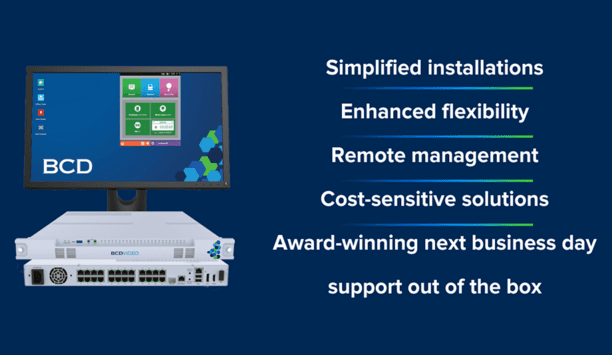
Understanding All-In-One Solutions
Download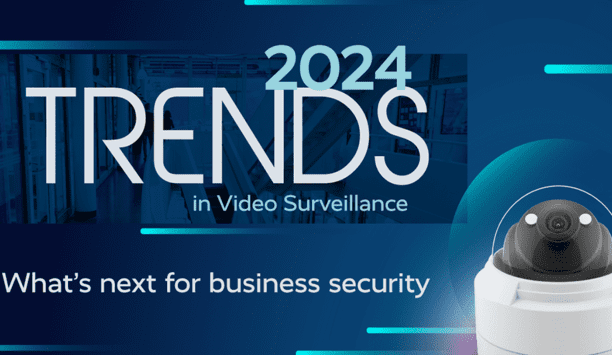
2024 Trends In Video Surveillance
Download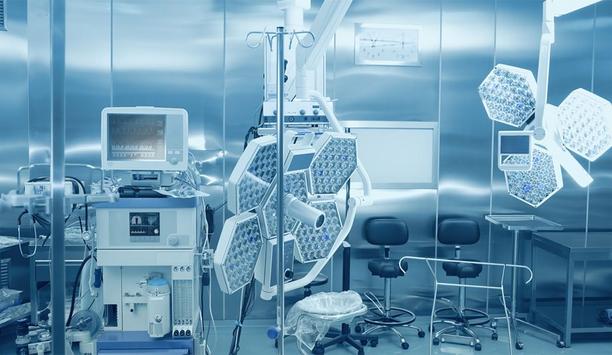
Healthcare Surveillance: Finding Efficiencies From OR To ER And Beyond
Download
Improving City Mobility Using Connected Video Technology
Download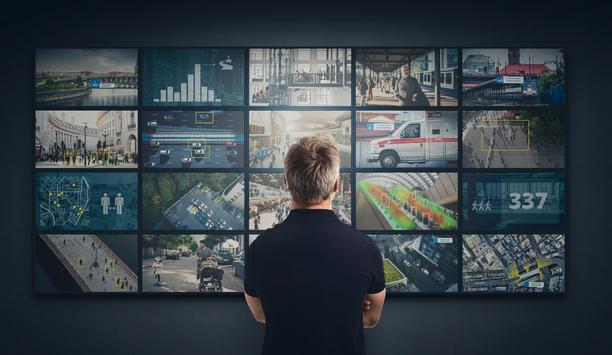
Connected Video Technology for Safe Cities
Download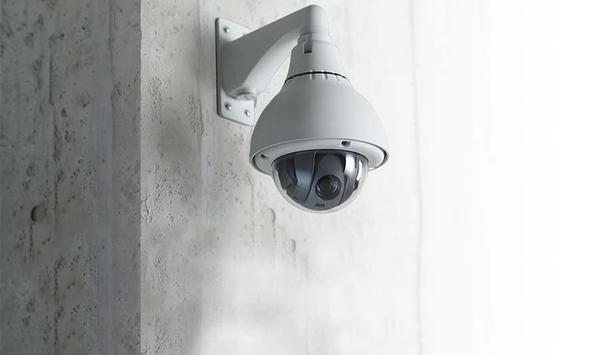
Security Investments Retailers Should Consider For Their 2021 Budget
Download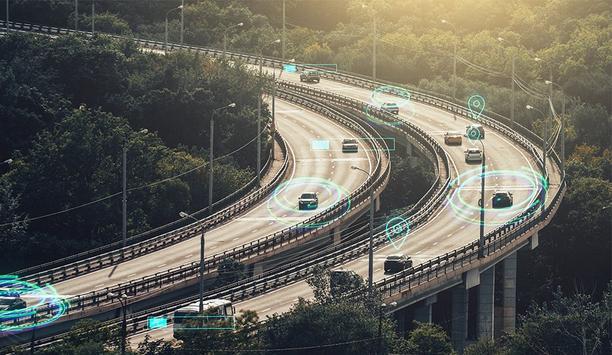
Optimize Your Business with Analytics and AI
Download
How End-to-End Video Security Solutions Can Help Your Organization With Social Distancing
Download
The Healthy Market For Video Surveillance At Medical Facilities
Download



